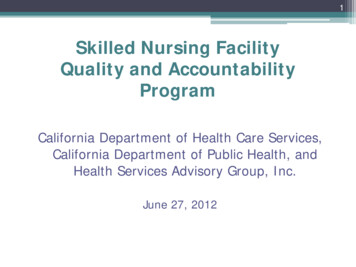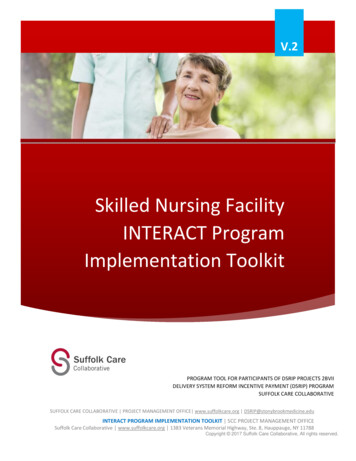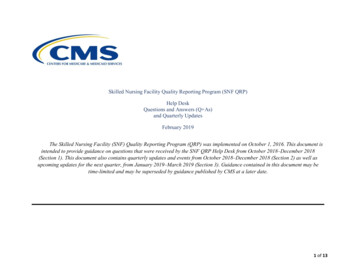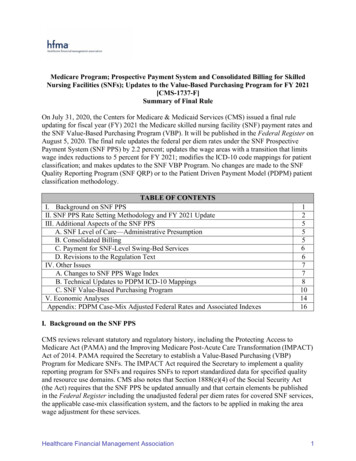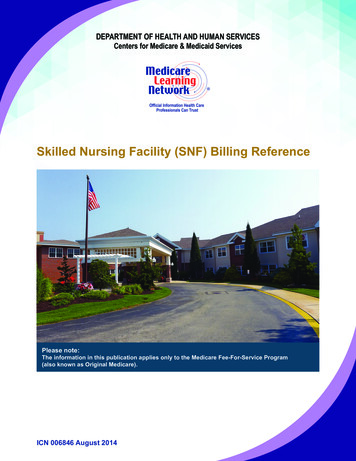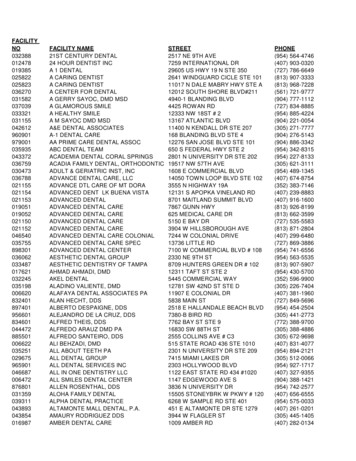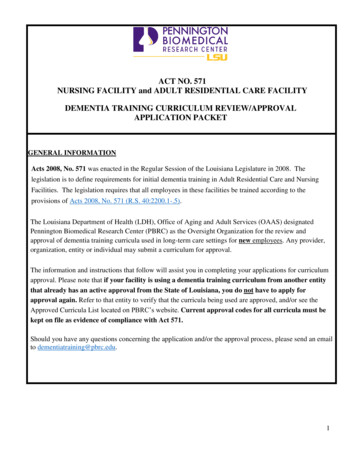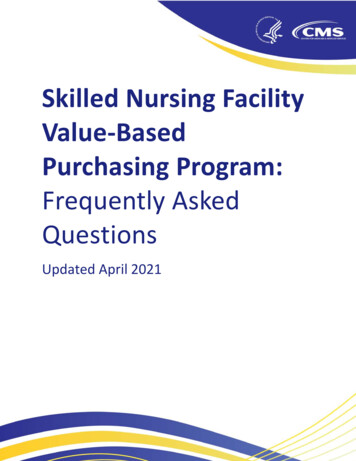
Transcription
Skilled Nursing FacilityValue-BasedPurchasing Program:Frequently AskedQuestionsUpdated April 2021
Table of ContentsProgram Information . 31. What is the Skilled Nursing Facility Value-Based Purchasing (SNF VBP) Program? . 32. Which SNFs are required to participate in the SNF VBP Program? . 3Measuring Readmissions . 33. What measure is used in the SNF VBP Program? . 34. What data periods does the SNF VBP Program use to assess performance? . 35. What information is used to calculate the SNFRM?. 46. What is the difference between a planned readmission and an unplanned readmission?. 47. What types of SNF stays are used to calculate the SNFRM? . 48. When does the SNFRM 30-day readmission risk window begin and end? . 59. Does the SNFRM count multiple hospital readmissions during a single 30-day readmissionrisk window? . 510. Why do my SNFRM results for the same data collection period differ across SNF VBPProgram years? . 511. Is the SNFRM also used in the SNF Quality Reporting Program (SNF QRP) or whencalculating star ratings on the Care Compare website? . 6Performance Scores, Rank, and Incentive Payments . 612. How are performance scores determined? . 613. How are performance standards determined for the SNF VBP Program?. 614. Can SNFs calculate their own achievement and improvement scores? . 715. My facility has scores of zero for achievement, improvement, and performance. Is this anerror? . 716. How are SNFs ranked in the SNF VBP Program? . 817. How are incentive payments determined? . 818. How do I interpret my SNF VBP Program incentive payment multiplier? . 819. Is there a scoring adjustment for SNFs without sufficient baseline period and/orperformance period data? . 9Quarterly Confidential Feedback Reports . 920. How will SNFs be notified of their performance in the Program? . 921. How can SNFs access their quarterly confidential feedback reports? . 1022. Why did my SNF not receive a quarterly confidential feedback report? . 10Review and Corrections . 1023. What is Phase 1 of the Review and Corrections process?. 1024. What is Phase 2 of the Review and Corrections process?. 1125. How do I submit a review and correction request? . 1126. How can I correct an error in my stay-level data?. 11
Public Reporting . 1127. Is performance in the SNF VBP Program publicly reported? If so, when? . 1128. What information is publicly reported? . 12Additional Resources . 1229. Where can I find more information or ask questions about the SNF VBP Program? . 12COVID-19 Resources for the SNF VBP Program . 1230. Will the COVID-19 public health emergency (PHE) impact SNF VBP Program policies? . 1231. What action do SNFs need to take to apply the national ECE policy? . 132
Program Information1. What is the Skilled Nursing Facility Value-Based Purchasing (SNF VBP) Program?The SNF VBP Program is a Centers for Medicare & Medicaid Services (CMS) program thatawards incentive payments to SNFs based on their performance on a single measure of allcause hospital readmissions. Section 215 of the Protecting Access to Medicare Act of 2014(PAMA) added sections 1888(g) and (h) to the Social Security Act, which required the Secretaryto establish a SNF VBP Program. The program began impacting SNF payments on October 1,2018. SNF VBP incentive payments are applied prospectively to Medicare Part A fee-for-service(FFS) claims paid under the SNF Prospective Payment System (PPS). CMS applies SNF VBPincentive payments to all SNF Medicare Part A fee-for-service claims. SNF VBP Programperformance is currently based on SNFs’ performance on the SNF 30-Day All-Cause ReadmissionMeasure (SNFRM)—a National Quality Forum (NQF)-endorsed quality measure (NQF #2510).2. Which SNFs are required to participate in the SNF VBP Program?The SNF VBP Program is not optional. All SNFs paid under the SNF Prospective Payment System(PPS) are required to participate in the SNF VBP Program. The types of SNFs that are paid underthe SNF PPS include freestanding SNFs, SNFs associated with acute care facilities, and all noncritical access hospital (CAH) swing bed rural facilities. Participation in the SNF VBP Programdoes not require any action on the part of SNFs to enroll nor does it require any additional datacollection burden. For more information on which SNFs qualify for low-volume adjustments,refer to Question 19.Measuring Readmissions3. What measure is used in the SNF VBP Program?The SNF 30-Day All-Cause Readmission Measure (SNFRM; NQF #2510) is the measure currentlyused in the SNF VBP Program. It evaluates the risk-standardized rate of unplanned, all-causeacute care hospital readmissions for Medicare FFS beneficiaries. The SNFRM assessesunplanned all-cause hospital readmissions for SNF residents within 30 days after discharge froma prior hospital stay to a SNF. For more detailed information about the SNFRM, please see theSNF VBP webpage and the SNFRM Technical Report.4. What data periods does the SNF VBP Program use to assess performance?The SNF VBP Program assesses SNF performance on the SNFRM during a baseline period and aperformance period. The following table provides the baseline and performance periods for theFY 2020 through FY 2023 Program years, as finalized through rulemaking.SNF VBP Program YearBaseline PeriodPerformance PeriodFY 2020FY 2016 (10/1/2015-9/30/2016)FY 2018 (10/1/2017-9/30/2018)FY 2021FY 2017 (10/1/2016-9/30/2017)FY 2019 (10/1/2018-9/30/2019)3
SNF VBP Program YearBaseline PeriodPerformance PeriodFY 2022FY 2018 (10/1/2017-9/30/2018)Q2-Q4 CY 2019 and Q3 CY 2020*(4/1/2019-12/31/2019 and7/1/2020-9/30/2020)FY 2023FY 2019 (10/1/2018-9/30/2019)FY 2021 (10/1/2020-9/30/2021)*For more information regarding SNF VBP Program adjustments in response to the COVID-19 public healthemergency, please see Question 30 and 31.5. What information is used to calculate the SNFRM?Data extracted from SNF and hospital Medicare Part A FFS claims submitted to CMS forpayment are used to calculate the SNFRM. The SNFRM does not use information from theMinimum Data Set (MDS) or patient medical records.6. What is the difference between a planned readmission and an unplanned readmission?The SNFRM evaluates the risk-standardized rate of unplanned acute care hospital readmissions.To determine if a hospital readmission is planned or unplanned, CMS uses the PlannedReadmission Algorithm. If a readmission does not meet the established criteria for a plannedreadmission according to the Planned Readmission Algorithm, it will be considered anunplanned readmission. Note the Planned Readmission Algorithm assesses diagnosis andprocedure coding information on the hospital claim only, not the SNF claim, to determine if areadmission is planned or unplanned. The following table lists the Planned ReadmissionAlgorithm version used for the FY 2020 through FY 2022 Program years.SNF VBP Program YearPlanned Readmission Algorithm VersionFY 20203.0FY 20214.0FY 20224.0For more detailed information about the approach to determine whether a readmission isplanned or unplanned, see Appendix A of the 2019 SNFRM Technical Report SupplementUpdate: SNF-VBP/Downloads/SNFRM-TechReportSupp-2019-.pdf7. What types of SNF stays are used to calculate the SNFRM?The SNFRM is calculated using 12 months of Medicare Part A FFS claims data. Several measureexclusions are applied. If a SNF stay meets any of the exclusion criteria, it will not be included inthe measure calculation. For example, patients with post-acute care admissions occurringwithin the SNFRM risk window (see Question 8) are excluded, as are patients discharged fromSNFs against medical advice. For the full list of exclusions, see pages 6-8 of the SNFRM TechnicalReport and pages 3-6 of the April 2017 SNFRM Technical Report Supplement.4
8. When does the SNFRM 30-day readmission risk window begin and end?The 30-day period during which an unplanned hospital readmission may be counted in theSNFRM is referred to as the risk window. The risk window begins when a patient is dischargedfrom an acute care hospitalization and subsequently admitted to a SNF within one day. The riskwindow ends either 30 days after its start or when a patient is readmitted to a hospital,whichever occurs first.For example, if a patient was discharged from a hospital to a SNF on September 1, 2018, thenreadmitted to the hospital on September 10, 2018, the risk window started on September 1and ended on September 10. If that same patient never experienced a readmission, the riskwindow would end 30 days after it started, on October 1, 2018.9. Does the SNFRM count multiple hospital readmissions during a single 30-day readmissionrisk window?No. The readmission risk window ends either 30 days after the discharge from an acute carehospitalization and subsequent admission to a SNF within one day, or when a patient isreadmitted to a hospital, whichever occurs first. If a patient has multiple readmissions, the riskwindow ends after the first readmission. However, additional risk windows may begin if allmeasure inclusion criteria are met.For example, if a patient was discharged from a hospital to a SNF on September 1, 2018, thenreadmitted to the hospital on September 10, 2018, the risk window started on September 1and ended on September 10. If that patient was subsequently discharged from the readmittinghospital to a SNF on September 15, a new 30-day risk window would begin. This new riskwindow would end on October 15 if the patient was not readmitted to a hospital.10. Why do my SNFRM results for the same data collection period differ across SNF VBPProgram years?The Planned Readmission Algorithm used by the SNFRM is updated periodically to ensure italigns with the latest clinical guidelines and is inclusive of all billing codes available for usewithin SNF Medicare Part A FFS claims. The SNF VBP Program also ensures the same version ofthe Planned Readmission Algorithm is used in a given Program year’s baseline and performanceperiods to maintain fair comparisons of SNF performance across data periods. This can result ina different version of the Planned Readmission Algorithm being used to assess performance forthe same data period.For example, the FY 2020 SNF VBP Program year’s performance period assesses the same dataperiod (FY 2018) as the FY 2022 SNF VBP Program year’s baseline period. However, theseProgram years use different versions of the Planned Readmission Algorithm. The FY 2020Program year used version 3.0, and the FY 2022 Program year used the latest version available,version 4.0, to assess FY 2018 data.5
The SNFRM uses the Planned Readmission Algorithm to determine whether a readmission isplanned or unplanned; if the Planned Readmission Algorithm used by the SNFRM changes, aSNF’s performance as measured by the SNFRM may change as well.11. Is the SNFRM also used in the SNF Quality Reporting Program (SNF QRP) or whencalculating star ratings on the Care Compare website?No. The SNF VBP Program uses the SNFRM, which calculates the risk-standardized rate ofunplanned, all-cause inpatient hospital readmissions within 30 days of a SNF patient’s dischargefrom a prior hospital stay.The SNF QRP uses the Potentially Preventable 30-Day Post-Discharge Readmission Measure,which is a different hospital readmission measure from the SNFRM. Measures used in the SNFQRP do not impact the SNF VBP Program in any way. For more information about SNF QRPmeasures, including the Potentially Preventable 30-Day Post-Discharge Readmission Measure,you may view the information on the SNF QRP webpage.The SNFRM is not used to calculate star ratings on the Care Compare website. For moreinformation about rehospitalization measures used to calculate star ratings on Care Compare,visit the Care Compare website.Performance Scores, Rank, and Incentive Payments12. How are performance scores determined?SNFs’ risk-standardized readmission rates (RSRRs) in the performance period are compared totwo metrics to determine the performance score: Their own past performance during the baseline period, used to calculate an improvementscore (scores range from 0 to 90)National SNF performance during the baseline period, used to calculate an achievementscore (scores range from 0 to 100)A SNF’s achievement and improvement scores are compared; whichever score is higherbecomes that SNF’s performance score.For complete information on how achievement and improvement scores are calculated,including formulas, see Question 14, the FY 2017 SNF PPS final rule (pages 52000 through52005) and the SNF VBP Program: FY 2021 Incentive Payment Multiplier CalculationInfographic.13. How are performance standards determined for the SNF VBP Program?There are two performance standards for the SNF VBP Program, the achievement threshold andthe benchmark. The SNF VBP Program’s achievement threshold is equal to the 25th percentileof all SNFs’ performance on the SNFRM during the Program year’s applicable baseline period.6
The SNF VBP Program’s benchmark is equal to the mean of the top decile of all SNFs’performance on the SNFRM during the Program year’s applicable baseline period.The performance standards for the SNF VBP Program are published in the SNF PPS final rulebefore the applicable Program year’s performance period begins.SNF VBPProgram YearAchievementThresholdBenchmarkSNF PPS Final RuleFY 20210.794760.83212FY 2019 SNF PPS final rule (page 39276)FY 20220.790590.82905FY 2020 SNF PPS final rule (page 38822)*FY 20230.792700.83028FY 2021 SNF PPS final rule (page 47625)*The FY 2022 SNF VBP Program year performance standards were initially published in the FY 2022 SNF PPS finalrule, and subsequently updated in April 2021 via a CASPER email announcement distributed to all SNFs.14. Can SNFs calculate their own achievement and improvement scores?Yes. A SNF can calculate its achievement and improvement scores using the following data: The SNF’s performance period RSRR, found in the performance period quality measurequarterly reports typically distributed in JuneThe SNF’s baseline period RSRR, found in the baseline period quality measure quarterlyreports typically distributed in DecemberThe applicable achievement threshold and benchmark for the Program year, found in theapplicable SNF PPS final rule and annual Performance Score Reports (PSRs) distributed inAugustNote: Inverted rates are calculated by subtracting the RSRR from 1 (1 – RSRR Inverted Rate).To calculate achievement and improvement scores SNFs may use the formulas below.SNF VBP Improvement Score:SNF VBP Achievement Score:The higher of the achievement and improvement scores becomes the SNF’s performance score.15. My facility has scores of zero for achievement, improvement, and performance. Is this an7
error?No. Achievement, improvement, and performance scores of zero are possible. Performanceperiod inverted RSRRs which are lower (i.e., worse) than the baseline period inverted RSRRs willresult in scores of zero for improvement. Performance period inverted RSRRs which are lower(i.e., worse) than the achievement threshold will result in scores of zero for achievement. Thebetter of the achievement and improvement scores becomes the SNF’s performance score, so ifboth of the above conditions are satisfied by a SNF, then this SNF will receive a performancescore of zero.16. How are SNFs ranked in the SNF VBP Program?SNFs are ranked by their performance scores each year, as required by statute. SNFs with thesame performance score receive the same rank. For example, if 200 SNFs receive a perfectperformance score of 100, these 200 SNFs will each hold a rank of 1. In this example, the SNFwith the next-highest performance score would receive a rank of 201.17. How are incentive payments determined?To fund the Program, each year CMS withholds 2 percent of SNF Medicare FFS payments, andeach year 60 percent of these withheld funds are redistributed to SNFs in the form of incentivepayments. CMS is required to redistribute between 50 and 70 percent of this withhold to SNFsas incentive payments; this 60 percent redistribution policy was finalized on pages 36619through 36621 of the FY 2018 SNF PPS Final Rule.To calculate incentive payments, CMS first estimates the dollar amount of SNF FFS Medicarepayments to be redistributed across SNFs in the applicable payment year, and then assignspayment incentive multipliers based on each SNF’s performance score using the logisticexchange function. To apply these incentive payment multipliers, the SNFs’ adjusted federal perdiem rates are multiplied by the incentive payment multiplier. For more information on howincentive payments are determined, see the SNF VBP Program: FY 2021 Incentive PaymentMultiplier Calculation Infographic, the SNF VBP Program Exchange Function MethodologyReport, and pages 36616 through 36621 of the FY 2018 SNF PPS final rule.18. How do I interpret my SNF VBP Program incentive payment multiplier?The incentive payment multiplier accounts for both the 2 percent payment withhold used tofund the Program and any incentive payments earned through performance. This multiplier willbe applied to your SNF’s adjusted federal per diem rate. When payments are made to SNFclaims, the adjusted federal per diem rate will be multiplied by the incentive paymentmultiplier. Multipliers are applied to payments for services provided during the applicable SNFVBP Program year. For example, incentive payment multipliers for the FY 2021 SNF VBPProgram year are applied to payments for services provided during FY 2021 (October 1, 2020through September
FY 2018 (10/1/2017-9/30/2018) FY 2021 . FY 2017 (10/1/2016-9/30/2017) FY 2019 (10/1/2018-9/30/2019) PROTECTING ACCESS TO MEDICARE ACT\r\nOF 2014. PROTECTING ACCESS TO MEDICARE ACT\r\nOF 2
